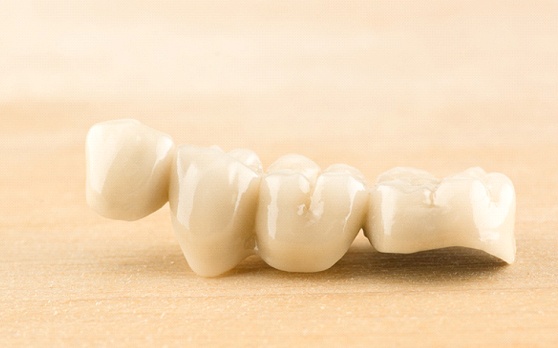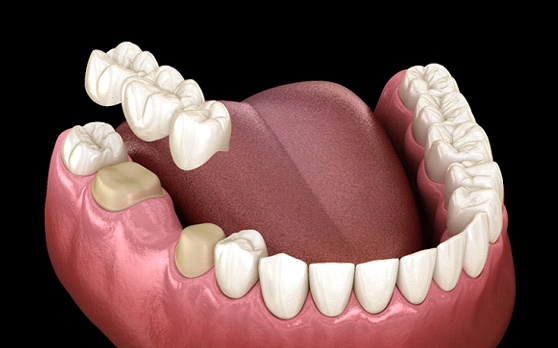Dental Bridges – Rockville, MD
No More Gaps
Missing multiple teeth can make eating, speaking, and smiling difficult. Not only can you face embarrassment when attempting to talk to others, but you likely struggle to speak clearly or even eat some of your favorite foods. Instead of moving through life with these unfortunate challenges, you can embrace a new attitude and appearance with the help of a dental bridge in Rockville. Our team is pleased to provide patients like yourself with high-quality prosthetics that are designed to repair and restore smiles with missing teeth. Whether you choose a traditional or more modern method (i.e., dental implants), you can achieve exceptional results. Contact us to schedule an appointment today.
What is a Dental Bridge?

Dental bridges are customized prosthetics that are designed to fit over healthy abutment teeth and fill in the gaps in a person’s smile. Using the teeth located on either side of the gap as anchors, a bridge is secured into place with the interior crowns resting on top of the gums. Instead of living in shame because of an incomplete smile, these time-tested and reliable prosthetics allow patients to enjoy a fully functional set of teeth once again.
Types of Dental Bridges

When meeting with a dentist in Rockville, patients must receive a thorough examination to ensure there is no existing tooth decay or gum disease. Once cleared for treatment, the discussion will lead to the types of dental bridges available. These include the traditional option or one held into place with dental implants.
Traditional Dental Bridge
A traditional dental bridge consists of three or more dental crowns that are fused to create a bridge. Using healthy abutment teeth that exist on either side of the gap, these are filed down to ensure a proper fit once the finished product is ready for placement. After the bridge is placed over these teeth, patients can expect a fully-functional smile that allows for easier eating, speaking, and smiling.
Typically, these types of bridges are placed in two visits and can last up to a decade with proper care and maintenance.
Implant Bridge
A more superior method of treatment is an implant bridge. These are crafted much in the same way but do not require the altering of healthy teeth. Instead, two dental implants are placed into the exterior sockets while the remaining interior crows rest on top of the gums. Not only does an implant bridge offer continuous stimulation to the jawbone, but it also improved bite strength and chewing power, greater clarity when speaking, and the ability to enjoy new and improved teeth for 30+ years or more.
What Are the Benefits of Getting a Dental Bridge?

Dental bridges offer an array of benefits that most patients cannot pass up. When you sit down to consider your options, you’ll find that with a dental bridge:
- You can enjoy many of the simplest tasks that we often take for granted such as smiling, speaking, and eating.
- You’ll enjoy a prosthetic that lasts years or even decades.
- Can strengthen your jawbone and help you maintain a more youthful appearance (i.e., implant bridge).
- Allows for improved oral health because you’ll feel good about the way you look and want to take care of your smile.
- Your natural teeth will not shift out of place.
Dental Bridges FAQs

If you’re missing one or a consecutive number of teeth, then you might consider getting a dental bridge to replace them. Since it’s important to choose the best restoration option for your smile, it’s a good idea to be well-informed about the treatment before committing to it. To help make this process easier for you, our team at Rockville Family Dentistry has collected and answered the most common questions we get about dental bridges in Rockville. Read along or give us a call if you wish to learn more today!
Is Getting a Dental Bridge Painful?
Just like most other dental procedures, we’ll first numb your mouth in the area we’ll be working on. This will allow you to remain comfortable while we prepare the teeth that’ll support your bridge. Although you shouldn’t experience any discomfort throughout the process, you might feel mild sensitivity for the following few days. You can easily manage this with over-the-counter pain relievers. Be sure to reach out to us if you do experience any persistent or worsening pain so we can address the issue.
Do Dental Bridges Feel Natural?
Your dental bridges should begin to feel increasingly natural within several days of receiving your restoration treatment. They’ll be constructed out of durable materials, such as ceramic or porcelain, so they’ll be able to withstand the excessive force from chewing. This means they’ll act like your natural tooth enamel and allow you to eat your meals comfortably. We’ll also design them to fit your exact smile specifications, so they shouldn’t feel or look noticeable in the long run.
How Many Teeth Can a Dental Bridge Replace?
Dental bridges can effectively replace anywhere between one to four consecutively missing teeth. The standard, however, is to typically use a bridge to restore one or two, as this will provide the most stability. The longer your restoration extends, or if your supporting teeth aren’t healthy or strong enough, the less secure it’ll be. If you need to replace more than two missing teeth successfully, then you might consider opting for implant bridges. These will be directly anchored to metal posts that were surgically embedded into your jawbone. Consult our team if this is something you’re interested in, and we’ll be happy to discuss a treatment plan for you.
Can You Take a Dental Bridge Out?
You should not be able to remove a dental bridge once it’s placed in your mouth. Only a dental professional like Dr. Shahram Modarres will be able to safely take them out whenever it’s time to replace your restoration. Dental bridges are not to be confused with partial dentures, although they can both restore a consecutive number of missing teeth. The main difference between the two treatments is that partials can be removed whenever a patient chooses to, while a bridge can’t. If you have further questions about this treatment, feel free to give us a call so we can get you started with a consultation!

